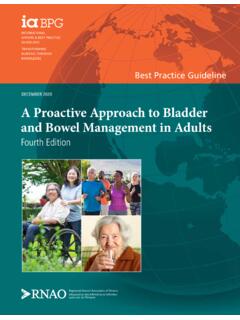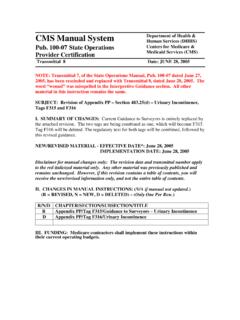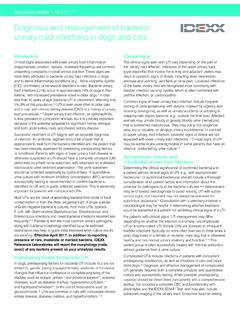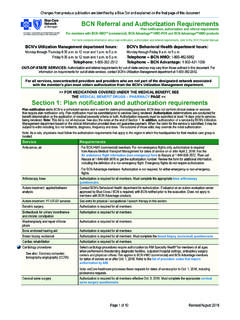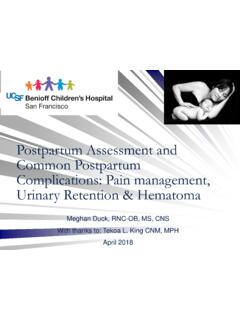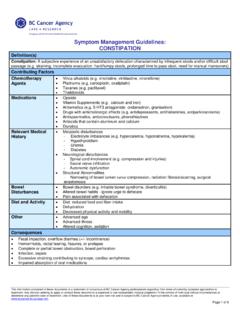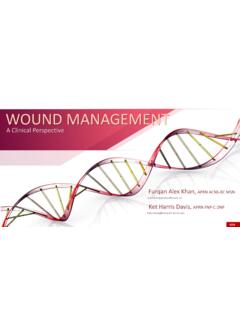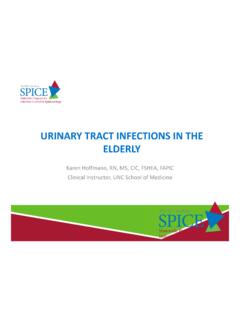Transcription of NANDA Nursing Diagnosis
1 NANDA Nursing Diagnosis Last updated August 2009, *=new Diagnosis 2009-2011 Activity/Rest-ability to engage in necessary/desired activities of life (work and leisure) and to obtain adequate sleep/rest Activity intolerance Activity intolerance, risk for Disuse syndrome, risk for Divisional activity, deficit Fatigue Insomnia Mobility: bed, impaired Mobility: physical, impaired Mobility: wheelchair, impaired Sedentary lifestyle Sleep deprivation *Sleep pattern disturbed Sleep, readiness for enhanced Transfer ability, impaired Walking, impaired Circulation- ability to transport oxygen and nutrients necessary to meet cellular needs *Bleeding, risk for Cardiac output, decreased *Tissue perfusion, decreased cardiac tissue, risk for *Tissue perfusion, ineffective, cerebral, risk for *Tissue perfusion, ineffective, renal, risk for *Tissue perfusion, ineffective gastrointestinal, risk for Tissue perfusion, ineffective, peripheral *Shock, risk for Ego Integrity- ability to develop and use skills and behaviors to integrate and manage life experiences Anxiety Anxiety, death Body image, disturbed Coping, community, ineffective Coping, community, readiness for enhanced Coping.
2 Defensive Coping, family, compromised Coping, family, disabled Coping, family, readiness for enhanced Coping, (individual), readiness for enhanced Coping, ineffective Denial, ineffective Energy field disturbance Fear Grieving Grieving, complicated Grieving, risk for complicated Health behavior, risk prone Human dignity, risk for compromised Personal identity, disturbed Post trauma syndrome Post trauma syndrome, risk for Power, readiness for enhanced Powerlessness Powerlessness, risk for Rape-trauma syndrome Relocation stress syndrome Relocation stress syndrome, risk for *Resilience, impaired individual *Resilience, readiness for enhanced *Resilience, risk for compromised Self concept, readiness for enhanced Self-esteem, chronic low Self-esteem, situational low Self-esteem, risk for situational low Sorrow, chronic Stress, overload Endo Blood glucose.
3 Risk for unstable Elimination- ability to excrete waste products Bowel incontinence Constipation Constipation, risk for Constipation, perceived Diarrhoea *Motility, dysfunctional gastrointestinal *Motility, risk for dysfunctional gastrointestinal urinary elimination, readiness for enhanced urinary elimination, impaired urinary incontinence , functional urinary incontinence , overflow urinary incontinence , reflex urinary incontinence , stress urinary incontinence , urge urinary incontinence , risk for urge urinary retention Food/fluid- ability to maintain intake of and utilize nutrients and liquids to meet physiological needs Breastfeeding, effective Breastfeeding, ineffective Breastfeeding, interrupted *Electrolyte imbalance, risk for Failure to thrive, adult Fluid balance, readiness for enhanced Fluid volume, deficient Fluid volume, deficient risk for Fluid volume excess Fluid volume, imbalanced, risk for Infant feeding pattern, ineffective Nutrition: imbalanced, less than body requirements Nutrition: imbalanced, more than body requirements Nutrition.
4 Imbalanced, risk for more than body requirements Nutrition, readiness for enhanced Oral mucous membrane, impaired Swallowing, impaired Gastro *Jaundice, neonatal Liver function, impaired, risk for Nausea Growth and development Dentition, impaired Development delayed, risk for Growth, disproportionate, risk for Growth and development, delayed Health promotion/Education Health maintenance, ineffective Health management , self, ineffective Health-seeking behaviors (specify) Immunization status, readiness for enhanced Knowledge deficient (specify) Knowledge (specify), readiness for enhanced Therapeutic regime management : family ineffective Hygiene- ability to perform activities of daily living *Neglect, self Self care, readiness for enhanced Self-care deficit, feeding Self-care deficit, bathing Self-care deficit, dressing Self-care deficit, toileting Life Principles *Activity planning, ineffective Decisional conflict Decision making, readiness for enhanced Moral distress Noncompliance (specify)
5 Hope, readiness for enhanced Hopelessness Religiosity, impaired Religiosity, readiness for enhanced Religiosity, risk for impaired Spiritual distress Spiritual distress, risk of Spiritual well being, readiness for enhanced Neurosensory- ability to perceive, integrate and respond to internal and external cues Autonomic dysreflexia Autonomic dysreflexia, risk for Communication, impaired verbal Communication, readiness for enhanced Confusion, acute Confusion, acute, risk for Confusion, chronic Environmental interpretation syndrome, impaired Infant behavior, disorganized Infant behavior, disorganized, risk for Infant behavior, organized, readiness for enhanced Intracranial adaptive capacity, decreased Memory, impaired Neurovascular dysfunction, peripheral risk for Sensory perception disturbed (specify).
6 Visual, auditory, kinesthetic, gustatory, tactile, olfactory Unilateral neglect Pain/discomfort- ability to control internal/external environment to maintain comfort *Comfort, impaired Comfort, readiness for enhanced Pain, acute Pain, chronic Respiration- ability to provide and use oxygen to meet physiological needs Airway clearance, ineffective Aspiration, risk for Breathing pattern, ineffective Gas exchange, impaired Spontaneous ventilation, impaired Ventilatory weaning response, dysfunctional (DVWR) Safety- ability to provide safe, growth-promoting environment Body temperature, imbalanced, risk for Contamination Contamination, risk for Falls, risk for Home maintenance, ineffective Hyperthermia Hypothermia Infection, risk for Injury, risk for *Maternal/fetal dyad, risk disturbed Latex allergy response Latex allergy response, risk for Perioperative positioning injury, risk for Poisoning, risk for Protection, ineffective Self mutilation Self mutilation, risk for Skin integrity, impaired Skin integrity, impaired, risk for Sudden infant death syndrome, risk for Suffocation, risk for Suicide, risk for Surgical recovery, delayed Thermoregulation, ineffective Tissue integrity, impaired Trauma, risk for *Trauma, risk for vascular Violence, self-directed risk for Violence.
7 Other-directed, risk for Wandering Sexuality (component of ego integrity and Social interaction)- Ability to meet requirements/characteristics of male/female role *Childbearing process, readiness for enhanced Sexual dysfunction Sexuality patterns, ineffective Social Interaction- ability to establish and maintain relationships Attachment, parent/infant/child, risk for impaired Care giver role strain Care giver role strain, risk for Family processes, dysfunctional Family processes, interrupted Family processes, readiness for enhanced Loneliness, risk for Parenting, impaired Parenting, readiness for enhanced Patenting, risk for impaired *Relationships, readiness for enhanced Role conflict, parental Role performance, ineffective Social interaction, impaired Social isolation Activity/Rest Activity intolerance.
8 Insufficient physiological or psychological energy to endure or complete required or desired daily activities Activity intolerance, risk for: at risk for experiencing insufficient physiological or psychological energy to endure or complete required or desired daily activities Disuse syndrome, risk for: at risk for deterioration of body systems as the result of prescribed or unavoidable musculoskeletal inactivity Diversional activity, deficient: decreased stimulation from or interest or engagement in recreational or leisure activities Fatigue: an overwhelming, sustained sense of exhaustion and decreased capacity for physical mental work at usual level Insomnia: a disruption in amount and quality of sleep that impairs function Mobility: bed, impaired: limitation of independent movement from one bed position to another Mobility: physical, impaired: limitation in independent, purposeful physical movement for the body or of one or more extremities Mobility: wheelchair, impaired: limitation of independent operation of wheelchair within the environment Sedentary lifestyle: reports a habit of life that is characterized by a low physical activity level Sleep deprivation: prolonged periods without sleep (sustained natural, periodic suspension of relative unconscious) *Sleep pattern disturbed: time-limited interruptions of sleep amount and quality due to external factors Sleep, readiness for enhanced: a pattern of natural, periodic suspension of consciousness that provides adequate rest, sustains a desired lifestyle, and can be strengthened Transfer ability, impaired.
9 Limitation of independence movement between two nearby surfaces Walking, impaired: limitation of independent movement within the environment on foot (or artificial limb) Circulation *Bleeding, risk for: at risk for a decrease in blood volume that may compromise health Cardiac output, decreased: inadequate blood pumped by the heart to meet metabolic demands of the body *Tissue perfusion, decreased cardiac tissue, risk for: risk for a decrease in cardiac (coronary) circulation *Tissue perfusion, ineffective, cerebral, risk for: risk for decrease cerebral tissue circulation *Tissue perfusion, ineffective, renal, risk for: at risk for a decrease in blood circulation to the kidney that may compromise health *Tissue perfusion, ineffective, gastrointestinal, risk for: at risk for decrease I gastrointestinal circulation Tissue perfusion, ineffective, peripheral: decrease in blood circulation to the peripheries that may compromise health *Shock, risk for: at risk fro an inadequate blood flow to the body s tissues which may lead to life-threatening cellular dysfunction Ego Integrity Anxiety: vague, uneasy feeling of discomfort or dread accompanied by an autonomic response, with the source often nonspecific or unknown to the individual; a feeling of apprehension caused by anticipation of danger.
10 It is an alerting signal that warns of impending danger and enables the individual to take measures to deal with threat. Anxiety, death: vague uneasy feeling of discomfort or dread generated by perceptions of a real or imagined threat to one s existence Body image, disturbed: confusion in mental picture of one s physical self Coping, community, ineffective: pattern of community activities (for adaptation and problem solving) that is unsatisfactory for meeting the demands or needs of the community Coping, community, readiness for enhanced: pattern of community activities for adaptation and problem solving that is unsatisfactory for meeting the demands or needs of the community but that can also be improved for management or current and future problems/stressors Coping, defensive: repeated projection of falsely positive self-evaluations based on self-protective pattern that defends against perceived threats to positive self regard Coping, family, compromised: usually supportive primary person (family member or close friend) provides insufficient, ineffective, or compromised support, comfort, assistance, or encouragement that may be needed to manage or master adaptive tasks related to heath challenge Coping, family, disabled: behavior of significant person (family member or other primary person) that disables his or her capacity to effectively address tasks essential to either person s adaptation to health challenges Coping, family, readiness for enhanced.



